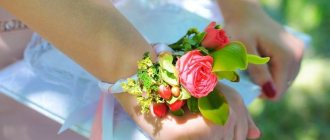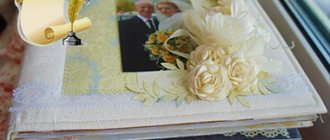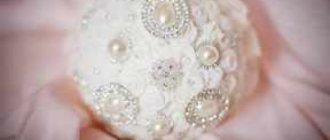Wedding bouquets made of polymer clay are one of the most creative types of accessories, without which it is impossible to create a full-fledged real image of the bride. Flowers made from polymer clay are an excellent replacement for living plants.
They will forever remain attractive and will become a memorable gift or reminder of the day when the newlyweds and their loved ones celebrated the birth of a new family. In addition to the fact that wedding bouquets made of polymer clay will forever retain freshness and attractiveness, they also have a number of other positive qualities, including light weight. It is not difficult for the bride to hold the composition in her hands for a long time and there is no need to fear for the safety and integrity of the bouquet.
Wedding bouquet made of clay
Nowadays, it has become fashionable to use unconventional solutions at weddings to make the celebration unforgettable, original, and different from others. This is expressed not only in organizing themed weddings, using unconventional images, colorful dresses for the bride, but also in making bouquets from very unexpected materials. Another such curiosity is a wedding bouquet made of clay. Indistinguishable from a real bouquet, it has many advantages that make it a worthy alternative to fresh flowers.
Making your own clay
You can buy polymer clay for crafts. If purchasing is not possible, do it yourself. The manufacturing process is easy and does not require large financial expenditures.
Ingredients
- Flour - 1 teaspoon;
- Corn starch - 1 teaspoon;
- PVA glue - 1 teaspoon.
- Oils for babies or baby cream - a few drops;
- A little acrylic paint.
Cooking method
Mix dry ingredients with PVA glue. Knead the mixture until it resembles clay. If the mixture sticks to your hands, drop a little baby oil or a little cream into it. If making a colored product, add paint.
Bride's bouquet made of polymer clay as an alternative to fresh flowers
Coming up with an alternative to fresh flowers in wedding arrangements has already become a certain kind of tradition. All this is done for aesthetic and practical reasons, because hand-made flowers are in no way inferior in appearance to real living ones, but have a number of characteristics that can be useful to the bride. Fresh flowers always bring a feeling of celebration, life, romance, tenderness. But they fade irrevocably, and it is difficult to do anything about it, and therefore even ardent adherents of traditional bouquets are beginning to think about alternative options. Clay has a lot to offer.
European roots of tradition
The custom of throwing a bouquet behind one’s back, rather than passing it in a round dance, came from Europe. There, the bride's outfit was also considered to bring good luck. And unmarried ladies believed in this so much that they tried to tear off at least a small piece from the bride’s dress. Can you imagine what it looked like after the holiday?
Naturally, the brides soon got tired of this, and they wanted to keep the wedding dress as a talisman that would bring good luck. Then it was invented to attach flowers to the dress, which guests were allowed to carefully remove for good luck. It was not very convenient to pin flowers to the outfit, and then the brides began to pick up a wedding bouquet, which they did not mind throwing to their bridesmaids at the end of the wedding.
Advantages of a bouquet made of polymer clay
The advantages of a clay wedding composition are undeniable:
- Durability. Fresh flowers often wither already at the ceremony, and this is a sad and terrible sight on such an optimistic holiday. Clay compositions will last unchanged not only during the wedding celebration, but also for many years after (if you do not drop the composition).
- Beauty. Craftswomen have learned to make clay flowers so skillfully that they will not only be indistinguishable from real ones, but even more beautiful. The buds they make are smooth, lush, always in the best shape, with the same desired size, desired tone, which cannot be said about fresh flowers, which may have natural flaws.
- Ease. A wedding bouquet created using polymer clay is lightweight. In weight it does not exceed 50 - 250 g, although at first glance it may seem otherwise. This will help the bride not to get tired too quickly, since wearing a heavy item for a long time is not an easy task.
- Variability. At any time of the year and under any conditions, the bride will be able to get married with the flowers in the wedding composition that she wants. And snowdrops in mid-August are no longer a fairy tale, but a real reality, accessible to any girl who chooses a clay wedding bouquet.
- Related accessories. Using clay, you can make not only a wedding composition, but also a beautiful boutonniere for the groom, decorate glasses, napkins, the bride’s hairstyle - all this will be in the same style, will not fade or lose its original appearance.
- Save time. A craftsman can make a handmade clay wedding composition long before the wedding, carefully place it in a safe place and calmly not think about it until the celebration. A composition of fresh flowers must be collected 20 minutes before the wedding (or picked up if it is done by florists). This creates even more excitement on such an important day, especially if there are any hiccups.
- Photogenic. Wedding clay arrangements have a photogenic look throughout the wedding, so you can take great photos at any time of the holiday, rather than rushing into a photo shoot at the beginning of the celebration.
- Symbolism. A bouquet from a wedding, kept in the family for many years, can always remain a symbol of the love of husband and wife, a reminder of a bright holiday. After many years, it can be shown to the children and grandchildren of the spouses, thereby forming in their minds the image of a happy family.
Role-playing games, lots and competitions
At any large wedding, in addition to the feast, various competitions and auctions are organized. Another good thing about such events is that the bouquet is preserved in its original, undamaged form and thus goes to its candidate.
A ritual with a bouquet can be turned into a competition with lots. To do this, you need to prepare beautiful ribbons, exactly as many as you want, to participate in the bride competition. These ribbons should be wrapped several times around the base of the flower arrangement, but only one should be tied with a strong knot. The ends of the ribbon should hang freely, so make sure they are long in advance. When the planned event begins, each unmarried girl must choose her own end of the ribbon; the one who gets the ribbon holding the bouquet is the lucky one.
Editor's choice: We select congratulations for your brother's wedding
- When preparing the script for the wedding, it is worth taking care of an unusual competition with the bride’s bouquet. The pirate version will serve as an example. You will need a chest with a lock for it; you can take a huge suitcase or box and transform it beautifully. The bride's bouquet is hidden in the chest in advance; it is better to use its double, and the key to the lock is mixed with other similar keys. The keys can be placed in a crystal vase, on a tray, or played in a competition. The bride's bouquet will go to the one who can open the chest with her key.
- Write the names of the girls on beautiful leaves, roll them into tubes, tie each of them with a silk ribbon and put it all in a beautiful vase. At the solemn moment, the bride takes out the treasured leaf at random, and thus determines who will receive the bouquet.
- A somewhat unusual, but interesting Greek version, about a shoe. The name of the bridesmaids is written with a felt-tip pen on the sole of the bride’s shoes, whose name remains at the end of the celebration or the next dance, and she will receive the desired bouquet.
- On a large Whatman paper, draw a labyrinth or a complex diagram, where a symbol marks the location of the lucky bouquet. The one who finds it first before finishing the competition will win.
All scenarios and examples with a wedding ritual about presenting a bouquet to the bride are good when the heroes of the occasion - the bride and groom - take part in their preparation. A few outside tips and tireless imagination will allow you to come up with your own, original tradition that can please both you and your guests.
Bouquet duplicate made of clay
But the impossibility of creating duplicate bouquets using clay is one of the disadvantages of such bouquets. Flower arrangements created with clay are fragile and hard products. Therefore, throwing them is highly not recommended: at best, it will simply break on the floor, at worst, it will injure one of the friends and guests trying to catch the stand-in bouquet. It’s better to make clay flower bouquets or bracelets for groomsmen - they won’t wither, won’t get wrinkled, and can be put aside without consequences to help the bride.
It is justified to make a clay double when the bouquet will not be thrown, but passed from hand to hand, for example, if there is only one unmarried friend or guest. Sometimes an ordinary small bouquet of fresh flowers is thrown into the crowd, and then a clay bouquet is presented as a duplicate, which the friend could keep as a souvenir.
Bouquet with ribbons: preparation
Many newlyweds are bored with the traditional method of throwing a flower arrangement to the bridesmaids. Delivering a bouquet using ribbons would be more original and no less intriguing. This interesting option will appeal to those who will have a lot of unmarried guests at their wedding. The good thing about it is that all the girls present have an equal chance of receiving the coveted bouquet.
To create an inexpensive bridal bouquet, you need to buy as many satin ribbons as there will be at the celebration of unmarried women. Experts note that ideally, each tape should be no shorter than 1.5 meters. Colors may vary. You can select them based on:
- wedding color scheme;
- colors of the interior of the banquet hall;
- colors of flowers in a bouquet.
You can choose ribbons of various colors. Plain products also look interesting, so the organizers do not give clear recommendations on this matter. One ribbon is tied to the wedding bouquet. The rest the bride simply clutches in her palms.
How to handle clay flowers
Flowers created using plastic (polymer clay) are reliable products. They are resistant to high temperatures, flexible - stronger than some stands and vases in which they can stand. However, there are certain factors that such flowers are afraid of. If you remember these things and do not expose your wedding bouquet to such influences, it will delight you with its beauty for a long time and remind you of a happy wedding.
What is a clay bouquet afraid of?
- A fall. Clay products are resistant to falls and impacts. But a lot depends on the quality of the material. Clay, which is the material for creating these wedding masterpieces, can be of two types - strong, but fragile, and less strong, but flexible. If your wedding bouquet is made of the first type, then if it falls, it will break completely or partially. If it’s from the second one, it can only bend, which can be fixed: just carefully straighten the bent part.
- Damage. If the wedding bouquet was not badly damaged when it fell, for example, a couple of branches or petals broke off, you can fix everything, so do not rush to throw away the broken parts. Take superglue and carefully glue the part to the fracture site - if you connect it accurately, no one will notice the damage. When making such compositions, the master himself uses glue to connect many parts.
- Moisture. Clay is very afraid of moisture, so wiping it with a damp cloth, getting it wet, putting it in a room with high humidity, playing with water near such a product, leaving it near children who can “water” the flowers is absolutely not allowed. Under the influence of moisture, a product created using plastic can become deformed or even soften. If drops do get on clay flowers, blot them with a dry cloth, but do not wipe them, and then leave the bouquet to dry on its own. You should also not use a hairdryer, heater or radiator for drying.
- Sun. Clay is not afraid of heat, but the paint that paints each flower is - it can fade, losing its original color. Therefore, try not to leave such flowers in direct sunlight.
- Low temperature. Plastic products are not afraid of high temperatures, but they are very afraid of low temperatures. If you place the product in a cold place, the clay will become brittle and will be damaged at the slightest application of force. If this does happen, return the bouquet to a warm place again and it will return to its previous state.
How to store
You need to store a clay bouquet from a wedding in a dry, warm room, not in direct sunlight, away from those who could spill it (including a possible neighbor’s flood and an accidentally overturned mug of tea), in places where dust settles weakly, for example, on glass . To remove accumulated dust from flowers, wipe them with a dry cloth or synthetic brush, which is sold in every office supply store. You can admire the product, pick it up with your hands (but not wet), don’t drop it - and your wedding bouquet will delight you for a long time!
Choosing an unconventional accessory, its pros and cons
When choosing an accessory, you should pay attention to its weight, number of colors, and the presence of sharp parts. No sharp stems or imitation thorns, even if the bouquet is made up of “roses”
The bride should be comfortable. The color is chosen according to your own taste to match the dress.
Bouquets made of polymer clay have advantages compared to accessories made from fresh flowers:
- They don't fade;
- During the holiday, you don’t have to worry that the flowers will fade and the photo in the bride’s hands will show something that doesn’t correspond to the festive mood;
- Such decorations sometimes look more attractive than classic ones. The colors are brighter, the flowers from which they are made are more original. Bouquet makers are not limited to the choice of flower shop assortment.
The disadvantage of polymer clay for flower bouquets is that it is a rather fragile material. If the accessory is dropped, it will no longer be possible to pick it up.
What about the traditional catching of the bride's bouquet? Prudent brides take care of this ritual in advance, purchasing a simpler bouquet, but made from living plants. But in the photo there is a wonderful bouquet in the hands of the bride.
Making flowers from polymer clay
Some people believe that an artificial accessory at a wedding is a bad omen. Long-lasting flowers are a symbol of eternal memory. They have no place at a wedding. Anyone who thinks so buys natural flowers.
It is not necessary to make a bouquet of scarlet or white roses from polymer clay and hold them in your hands during a special event. These flowers would look more appropriate on the hood of a car.
The fashion for decorating a vehicle has not changed for many years. By the way, English brides used to decorate cab doors with clay plants back in the 12th century.
Master class on making roses
It is necessary to prepare the following materials in advance:
- polymer clay;
- stationery knife;
- stack;
- rubber gloves that fit the hands;
- toothpick or thin knitting needle;
- a flat wooden board, similar to a hot stand.
Without a level stand it will be impossible to sculpt. Not everyone can feel the material in gloves.
If you are not afraid to get your hands dirty, you can sculpt without wearing protective equipment:
- To begin with, a ball of such a size is separated from the material that it will later be enough for a petal. The amount of clay depends on the future size of the flower;
- The ball is rolled, warmed in the hand, then kneaded so that a thin, flat and even - if possible - oval is obtained;
- The plate is twisted into a loose tube diagonally, giving it the shape of a pink oblong petal. This will be the core of the future rose;
- A semblance of the core of a rose bud is put on a toothpick.
The remaining petals are made in exactly the same way as the first, only the sizes change - each next petal is slightly larger than the previous one. All petals are adjusted to each other, tightly placing one on top of the other. The circle should be even.
Corners are formed on the outer petals, this way a more accurate imitation of a rose is achieved. Now you need to sculpt a sepal and several pink leaves.
You need to act according to the already known order:
- Make a small ball;
- Create an oval out of it by rolling it into a thin plate;
- Using the end of a toothpick, apply embossed veins to the leaf;
- Bend the edges so that the cup looks “lifelike.”
Then the sculpted leaf is placed on the bud, covering the lower part of the finished inflorescence.
The process will have to be repeated 4-5 times, this is how many sepals a real rose has.
Then they roll out the polymer material thinly and wrap it around a toothpick to create a stem. Leaves formed according to the described algorithm are attached to it.
If white clay was used for the flowers, they then need to be painted with acrylic paint. In this process you can no longer do without gloves. Paint the products after the material has dried.
We choose the colors that we want. It is not necessary to stick to the traditional “pink” color. However, now flower growers have learned to grow roses of all colors and shades: ultramarine, green, even black. On average, you need to spend about an hour on 1 flower.
Features of the composition
If previously it was believed that the bride must wear an accessory made of fresh flowers, today many replacements have been invented for this solution. Polymer clay allows you to create buds that are indistinguishable from real ones, especially if you practice a little before starting to compose the main composition.
A clay wedding bouquet has several advantages.
- Durability. The bride will be able to keep her wedding accessory for many years; it will decorate the interior without making the decoration tasteless. Instead of the main composition at the end of the wedding, a girl can throw a backup made of fresh flowers to her unmarried girlfriends.
- Ease. A fully assembled bouquet made of polymer clay weighs no more than 300 g, so the bride will be able to move freely throughout the day without fatigue.
- Versatility. From this material you can create any flowers of different shades. A bride can come to a summer wedding with snowdrops, to a winter wedding with irises, etc. Fantasy wedding bouquets made of polymer clay, as in the photo, are very popular among modern brides.
- Advance preparation. Polymer clay never loses its original appearance, so the accessory can be made even several months before the wedding. This frees the bride from additional hassle on her special day.
- Photogenic. In photographs, flowers made from polymer clay look much brighter and more saturated than real flowers.
So as not to offend anyone
A wedding is a joyful event not only for the newlyweds, but also for the guests. In order not to deprive all unmarried girls of playful pleasure, especially if there are only 2-3 of them left, you can give a bouquet to everyone. The situation is saved by a large, chic bouquet, which, if desired, can be easily divided into parts. Before throwing flowers, the bride just needs to untie the ribbon and she will have three bouquets in her hands at once, which she will throw without looking at her surprised and happy girlfriends. The whole beauty of this idea is its unexpectedness; don’t let anyone else know about your planned plan, and everything will go as well as possible.
Editor's choice: How to have a wedding inexpensively and beautifully
Compatibility with the style of the celebration
Since you can mold anything that comes to mind from polymer clay, such a bouquet will suit any wedding style. For a classic celebration, the composition is made up of standard plants - roses, lilies, orchids or callas, all of which can be fashioned from pliable material. In this case, you can give the composition any shape, but a hemispherical one will look most harmonious. Wildflowers made from polymer clay are suitable for celebrations in boho, rustic or country style.
Artificial lavender will be useful for a Provence-themed wedding, since fresh flowers can be expensive. For a vintage wedding or shabby chic decoration, roses, peonies and eustomas are suitable.
You can create not only flowers from polymer clay - you can make all additional accessories yourself. For example, for a nautical wedding they sculpt shells, starfish, skates, anchors, steering wheels, etc., for a steampunk style - gears, nuts, bolts, springs and other mechanical parts. Even pearls and decorative greenery can be made from this material to complement the composition.
Bride's image
Depending on the colors chosen, the accessory can suit any style of the hero of the occasion. This composition will complement the look in a tight or fluffy dress, short or long, with or without a train. The same applies to other accessories - shoes, handbags, gloves, etc.
The bride's hairstyle can also be different. Classic roses, lilies or orchids will be paired with a strict, elegant styling; wildflowers will be paired with loose curls or a slightly careless composition.
It is better to make the manicure monochromatic or French, since the abundance of details on the nails will distract from the appearance of the bouquet.
DIY composition
If the bride decides to create an accessory from polymer clay herself, she will need to purchase the necessary materials. You need to buy self-hardening plastic in the desired shades - these are the future flowers.
In addition to this, you will need wire, oil paints or pastels, glue, wooden sticks (stacks) and scissors. You may also need molds for cutting out finished blanks (cutters) and templates for imprinting the texture of the petals. All this is sold in craft stores.
A beginner can make the following flowers from polymer clay:
A bouquet of daisies will look original in the hands of the bride. To make it, you will need white, green and yellow clay, as well as all the tools listed. First, the wire is covered with a layer of green plastic - this is the future stem. One end of it needs to be bent into a small loop so that the tip is directed to the side.
To create the core, you will need to roll two small balls of yellow and green clay, place the first on the second and press through a small piece of tulle to create the desired texture. Excess edges are trimmed with small scissors.
After this, the petals are made - two inflorescences are cut out of white clay using a cutter. Veins are made on one of them using a wooden stick, and the edges are torn off a little to create barely noticeable teeth at the tips. The petals are torn off from the second workpiece, processed using a stack and attached to the first in a suitable order, after which they are fixed on the stem. All elements are left until completely dry.
At the next stage, the core is glued to the center of the inflorescence. A receptacle is molded from green clay, which is attached to the bottom of the chamomile. You can give it the desired texture if you randomly make cuts 1-2 mm long with scissors. A leaf is made from plastic of the same color using an appropriate shape, which is attached to the stem.
The flower is left until completely dry and, if necessary, painted over. Ready-made daisies are attached to a hemispherical foam base with a handle, which is decorated with a satin ribbon.
Sequence of work
Paint the clay with a brush, and form a small protrusion in the center of the piece. To make the center of the flower, cut a cross from a piece of clay using a cutter. If there is no form for cutting, you must do it yourself with a knife. The ends of the cross-shaped workpiece are consistently bent inward.
Then bend the wire at an angle of 90 degrees. Place the center of a flower coated with glue onto the end of the wire.
Make the middle of the flower in the form of a small grain, on which an incision should be made, and place it in the center of the orchid. The flower is decorated in all available ways.
A painted piece of clay with a projection is rolled out and placed in a mold. The required number of petals is made in the same way.
In case of difficulties encountered during the work, it is recommended to familiarize yourself with photos and video master classes on making flowers from polymer clay published on the world wide web.
Additional Tips
In addition to her own bouquet, the bride can make a boutonniere for the groom or wrist flowers for the bridesmaids from polymer clay. You can decorate champagne glasses and ring cushions with matching accessories. Accessories on tables can also be made from this material in advance to save on fresh flowers. However, it is not recommended to make a stand-in bouquet from polymer clay, as it will be fragile.
Creating a bridal floral arrangement from self-hardening plastic is a fascinating process. The girl will be able to have a good time and at the same time create her own image, put her own individuality and imagination into it. A handmade bouquet, indistinguishable from the real thing, will definitely be appreciated by the groom and guests.
How to make a boutonniere
Often brides prefer not to use the services of florists, but want to make their own wedding boutonnieres
When making such a decision, it is important to resort to a trial version and practice in advance in decorating this decoration. In this case, you will get a truly original and memorable gift for your future spouse.
Ideas for successful compositions can always be found on the Internet; there are also detailed master classes that clearly explain how to make a boutonniere from fresh flowers or improvised decorative materials.
To make the chosen composition, you will definitely need not only the flowers themselves and the accompanying decor, but also “working” materials - scissors, a glue gun or PVA glue, tape, floral wire, a special liquid for impregnating living plants, etc.
Advantages and disadvantages
What can be said in favor of bouquets made from flowers made from polymer clay? First of all, this is their incredible similarity to living plants. Clay flowers, viewed from afar, are simply impossible to distinguish from real ones. Besides:
- The bouquet is light.
- The finished product has a high degree of strength. It can only be broken, but if you handle this miracle carefully, the bouquet will delight others for many years after the wedding.
- The bride does not need to collect a bouquet of flowers that are common at this time of year. In winter and spring, summer and autumn, a girl can create a composition using the flowers that she prefers.
- Clay flowers have the size and shade of color that the bride needs to highlight the beauty of her dress and wedding style.
- At the same time as making the components for the wedding bouquet, the master also makes other accessories. This is a boutonniere, a composition of flowers for the bride’s hand and bracelets for her bridesmaids, hairpins and other decorations that complement the outfit.
Newlyweds do not need to worry that a pre-prepared bouquet will lose its freshness and attractiveness. Even if made a few weeks before the celebration, it will remain the same as the bride first saw it.
In wedding photographs, the difference between flowers made of polymer clay and living plants is completely invisible. Those who do not know what kind of bouquet the bride is holding will not be able to understand that it is made of clay.
Roses and blueberries
We will need:
- plastic (polymer clay) yellow, blue and white;
- floral wire and ribbon;
- flowerpot, basket, etc.;
- foam base.
From yellow plastic (we can mix in a little white for a more delicate color), we first form balls of different sizes, and then roll out the petals on the palm of our hand from the center to the edge. Moreover, you can do this with the pad of your finger, but you can take a special tool with a ball at the end. When all the petals are ready, roll up a droplet from the same plastic and begin to apply petals to it, starting with small ones. We place the petals overlapping each other.
Moreover, starting from the second row, we bend the top edge outward.
We stick a wire into the base of the flower and set it aside so that the plastic sets. If you choose baked clay, first put it on a skewer, stick it into a ball of foil and put it in the oven. See the plastic packaging for time and temperature.
Now let's move on to the blueberries. We take several pieces of blue plastic and mix different amounts of white into them. Then we roll them into balls. To give it a natural look, lightly squeeze the ball and put a dimple on top with the rod from the handle. We string each berry onto a wire and form a twig, wrapping it with floral tape.
We make leaves using the same principle as in the previous example. The only thing is that you can take a pure color and roll it out on your palm.
We attach them to a blueberry branch. Moreover, as we see in the photo, the berries on the branch below are not only blue, but also white, simulating unripe ones.
Now we place the foam base in a flowerpot or other container. And we begin by sticking blanks of flowers and berries into it to form a bouquet.
As you can see, the principle of working with polymer clay is quite simple. Both a novice craftswoman and an already experienced needlewoman can make flowers with their own hands. And having learned how to make individual flowers, you will be able to create amazingly beautiful bouquets that at first glance will be impossible to distinguish from real flowers. Such compositions can be suitable as decorations for the interior, from which you only need to sweep away the dust, as a wedding bouquet and boutonniere for the groom, or just a bouquet as a gift. Below is a selection of videos of some color options.
Master Class
To make a bouquet from polymer clay yourself, you first need to familiarize yourself with the master class.
This will make it possible to understand the peculiarity of this plastic material, after which it is worth carefully studying the technique of making blanks and the order of assembling flowers. Experienced craftsmen claim that no special skill is required to perform such work. Even a beginner can cope with the task.
First you need to purchase the material itself, divide it into parts and paint it. To do this, you will need special dyes, which can be purchased at a low price. A small amount of the coloring composition is applied to the white clay and the clay is thoroughly kneaded in your hands until it is all evenly colored.
Now you can lightly lubricate your hands with cream and start working on creating blanks for flowers. These are the core and petals.
The core is a small piece of clay that needs to be shaped into a cone. Having achieved the desired result, the workpiece is left aside to cool.
Next step. Roll the “sausage” 1 cm thick and divide it into small pieces of equal size. You will need to work with one, and the rest will need to be covered with a damp cloth at this time to allow the clay to dry. Make a small circle from each piece, one edge of which is slightly thinner.
This will be the top edge of the petal, slightly curved or wavy. The petals are glued one by one onto the prepared core, giving them the desired shape. An important condition: each subsequent petal is glued so that its edge falls in the middle of the previous one. The petals are given the desired shape immediately, as after drying (it will be impossible to change anything).
The finished flowers are placed on a stand made of polystyrene foam or foam rubber to prevent falling and not to crush the finished flowers while they harden.
Stages of work on making a rose
Roll a cylinder out of clay, cut it into unequal sections, from which roll into balls. The resulting balls should be of different sizes.
Make petals out of them in the shape of an ellipse. To do this, press the workpiece with your thumb to make it flat, and then a petal is formed from each ball.
Then a bud is assembled from the resulting petals, successively increasing the size of the petals towards the periphery. When assembling, you should assemble the bud so that the next petal covers at least the middle of the previous one. This rose will look good as a magnet on the refrigerator.
Containers for artificial flowers
An artificial bouquet made by yourself can stand in different containers:
- In pots. Classic option.
- In vases. It will look very original if you fill a glass vase with smooth pebbles and multi-colored balls.
- In wicker baskets. They look very cute and cozy.
- In a flowerpot. A cover, for example, a knitted one, is put on the pot, and it is hung from the ceiling by a loop.
- In bottles or glasses (suitable for miniature compositions).
In addition to beautiful decorative compositions, you can make a bouquet of artificial flowers with your own hands for a beautiful bride or simply as an interior decoration. Below we will look at the most interesting ideas.










